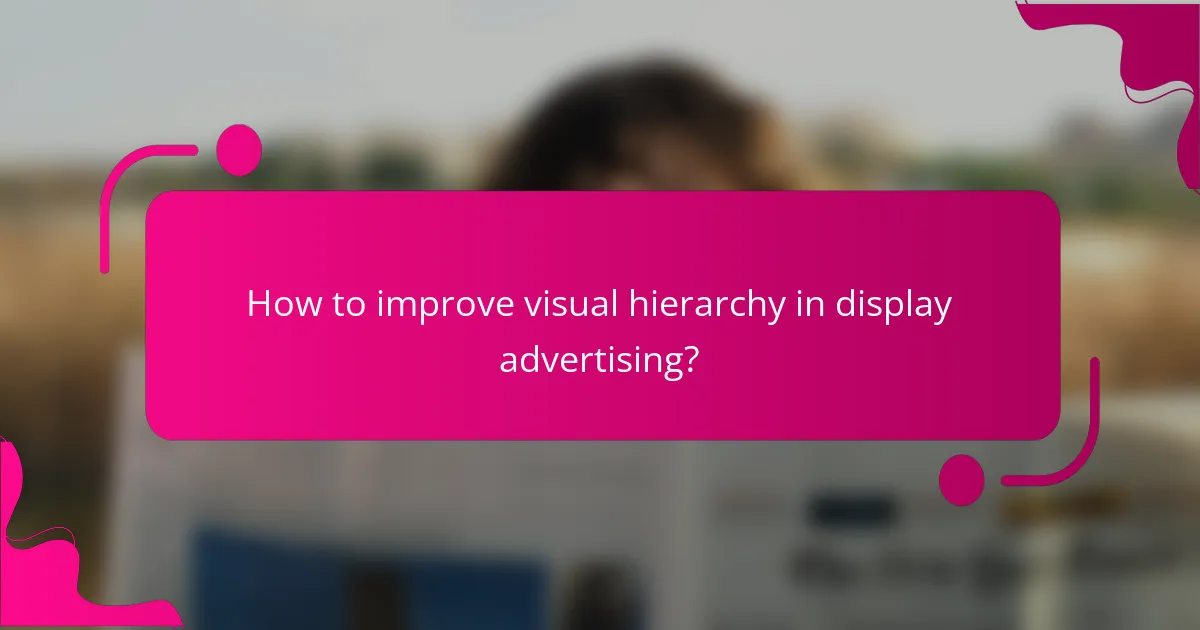Visual hierarchy is essential in design, as it organizes elements to guide viewers’ attention and enhance clarity. By employing techniques such as color contrast, layout structure, and typography, designers can effectively direct focus and improve user engagement. A well-structured layout not only aids comprehension but also highlights key information, making it easier for audiences to absorb content.

How to improve visual hierarchy in display advertising?
Improving visual hierarchy in display advertising involves organizing elements to guide viewers’ attention effectively. This can be achieved through techniques like color contrast, layout structure, and strategic content placement.
Use contrasting colors
Contrasting colors help important elements stand out, making them more noticeable to viewers. For instance, using a bright color for a call-to-action button against a muted background can significantly increase click-through rates.
When selecting colors, consider the emotional impact and cultural associations. For example, red can evoke urgency, while blue often conveys trust. Aim for a balance that aligns with your brand identity.
Implement grid layouts
Grid layouts provide a structured framework that enhances clarity and organization in display ads. By aligning elements within a grid, you create a sense of order that makes the ad easier to digest.
Consider using a simple two or three-column grid for most ads. This allows for clear separation of text and images, ensuring that each component has its own space without overwhelming the viewer.
Prioritize content placement
Content placement is crucial for directing viewer attention. Key information should be positioned in areas where eyes naturally fall, such as the top left or center of the ad.
Use the F-pattern layout, where viewers typically scan from left to right and top to bottom. Place the most important elements along this path to maximize visibility and engagement.
Utilize whitespace effectively
Whitespace, or negative space, is essential for creating breathing room around elements in display advertising. It helps to reduce clutter and allows viewers to focus on the most important aspects of the ad.
Aim for a balanced use of whitespace to enhance readability. For instance, leaving space around text and images can improve comprehension and make the ad more visually appealing.
Incorporate visual cues
Visual cues, such as arrows or icons, can guide viewers’ attention and indicate actions. These elements help clarify the message and encourage interaction with the ad.
For example, using an arrow pointing towards a “Buy Now” button can effectively direct users to take action. Ensure that these cues are intuitive and align with the overall design to maintain coherence.

What layout techniques enhance focus and clarity?
Effective layout techniques enhance focus and clarity by guiding the viewer’s eye and organizing information logically. Utilizing established patterns can significantly improve user engagement and comprehension.
F-pattern layout
The F-pattern layout is based on how users typically read web content, which often resembles the letter “F.” This layout emphasizes the top and left areas of the page, where the most critical information should be placed.
To implement an F-pattern, position key elements such as headlines, images, and calls to action along the top and left margins. This approach is particularly effective for text-heavy sites, as it aligns with natural reading habits.
Z-pattern layout
The Z-pattern layout is effective for pages with less text and more visual elements. It guides the viewer’s eye in a zigzag pattern, moving from the top left to the top right, then diagonally down to the bottom left, and finally to the bottom right.
Use the Z-pattern for landing pages or promotional content where you want to direct attention to specific elements, such as images or buttons. This layout works well for mobile devices, where screen space is limited.
Card-based design
Card-based design organizes content into distinct, manageable sections or “cards,” making it easy for users to scan and digest information. Each card typically contains an image, title, and brief description, allowing for quick comparisons.
This design is particularly useful for e-commerce sites or portfolios, where multiple items need to be displayed clearly. Ensure that cards are visually consistent and maintain a uniform size to enhance the overall layout and user experience.

What role does typography play in visual hierarchy?
Typography is crucial in establishing visual hierarchy, as it guides the reader’s attention and enhances comprehension. By manipulating font size, weight, and spacing, designers can create a clear structure that highlights important information and improves overall readability.
Font size and weight
Font size and weight significantly impact how information is perceived. Larger font sizes naturally draw attention, making them ideal for headings or key points. Similarly, bold weights can emphasize critical text, while lighter weights may be used for body copy to create a contrast that aids in readability.
When selecting font sizes, consider a range of 16-24 pixels for body text and 24-36 pixels for headings, depending on the overall design. Ensure that there is a clear distinction between different text elements to maintain a logical flow.
Line spacing and alignment
Line spacing, or leading, affects readability and visual comfort. A spacing of 1.5 to 1.75 times the font size is often recommended for body text to prevent crowding. Proper alignment, whether left, center, or justified, also plays a role in guiding the reader’s eye and maintaining a clean layout.
For example, left-aligned text is generally easier to read in Western cultures, while centered text can be effective for titles or short statements. Avoid excessive justification, as it can create uneven spacing between words, making reading more difficult.
Font pairing strategies
Effective font pairing enhances visual hierarchy by creating contrast and harmony. A common strategy is to pair a serif font for headings with a sans-serif font for body text, as this combination provides a clear distinction between different text elements.
When choosing fonts, limit yourself to two or three complementary typefaces to avoid visual clutter. Ensure that the fonts share similar characteristics, such as x-height or stroke width, to maintain a cohesive look throughout the design.

How can user testing improve visual clarity?
User testing enhances visual clarity by providing direct insights into how real users interact with a layout. By observing user behavior and gathering feedback, designers can identify areas of confusion and make informed adjustments to improve overall usability.
A/B testing layouts
A/B testing involves comparing two or more layout variations to determine which one performs better in terms of user engagement and clarity. By randomly assigning users to different versions, designers can gather data on metrics like click-through rates and time spent on page.
When conducting A/B tests, it’s crucial to focus on one variable at a time, such as button placement or font size. This allows for clearer insights into what changes impact user experience. Aim for a sample size that provides statistically significant results, typically in the low hundreds to thousands, depending on your audience size.
Gathering user feedback
Collecting user feedback is essential for understanding how effectively a layout communicates information. Surveys, interviews, and usability tests can reveal user perceptions and pain points regarding visual elements.
Encourage users to express their thoughts on clarity and ease of navigation. Open-ended questions can provide deeper insights, while rating scales can quantify user satisfaction. Regularly incorporating feedback into design iterations helps create a more intuitive experience.
Analyzing heatmaps
Heatmaps visually represent user interactions on a webpage, showing where users click, scroll, and hover. This analysis helps identify which areas attract attention and which are overlooked, providing valuable insights into visual hierarchy.
Using heatmaps, designers can assess the effectiveness of specific elements, such as calls to action or images. Look for patterns that indicate confusion or disengagement, and adjust the layout accordingly to enhance clarity and focus. Tools like Hotjar or Crazy Egg can facilitate this analysis effectively.

What are the best practices for mobile visual hierarchy?
Effective mobile visual hierarchy enhances user experience by guiding attention and ensuring clarity. Key practices include utilizing responsive design principles and optimizing touch target sizes to create intuitive navigation and interaction.
Responsive design principles
Responsive design principles ensure that content adapts seamlessly to various screen sizes and orientations. This involves using flexible grids, images, and CSS media queries to maintain a consistent layout across devices.
Consider prioritizing content based on importance, placing the most critical information at the top or center of the screen. For example, headlines should be larger and bolder than body text, making them stand out and easier to read.
Touch target sizing
Touch target sizing is crucial for mobile usability, as users interact with screens using their fingers. Aim for touch targets to be at least 44×44 pixels, which is the recommended minimum size to ensure easy tapping without errors.
Additionally, maintain adequate spacing between touch targets to prevent accidental clicks. A good practice is to leave at least 8-10 pixels of space between buttons and links, enhancing the overall user experience.
